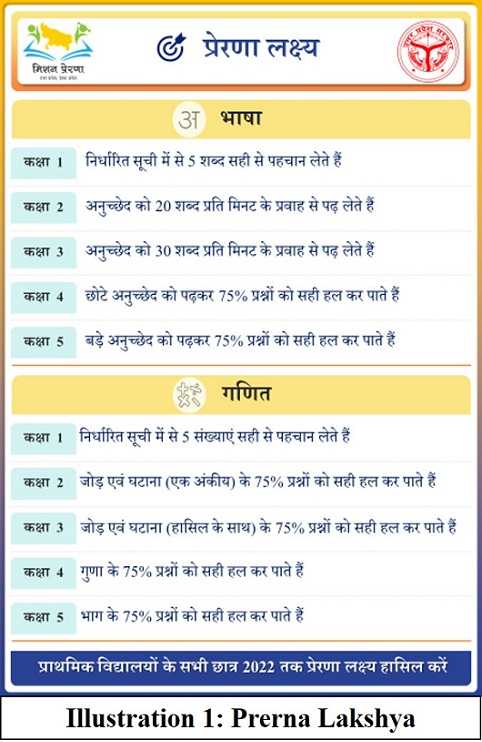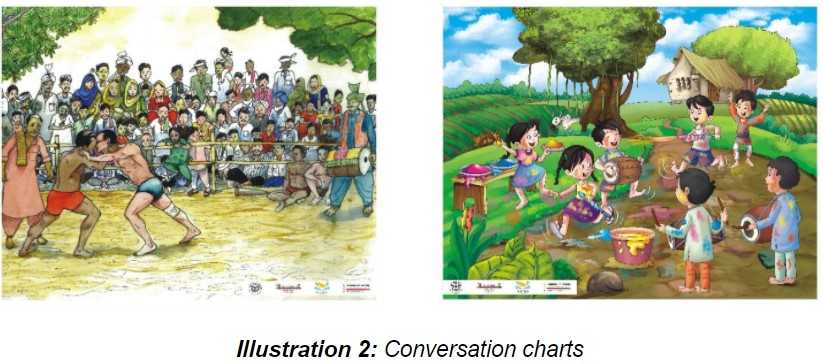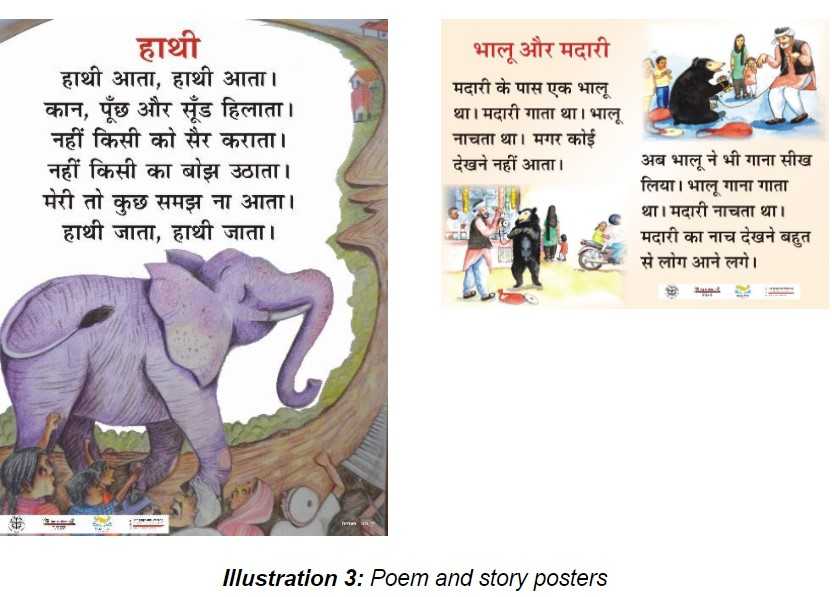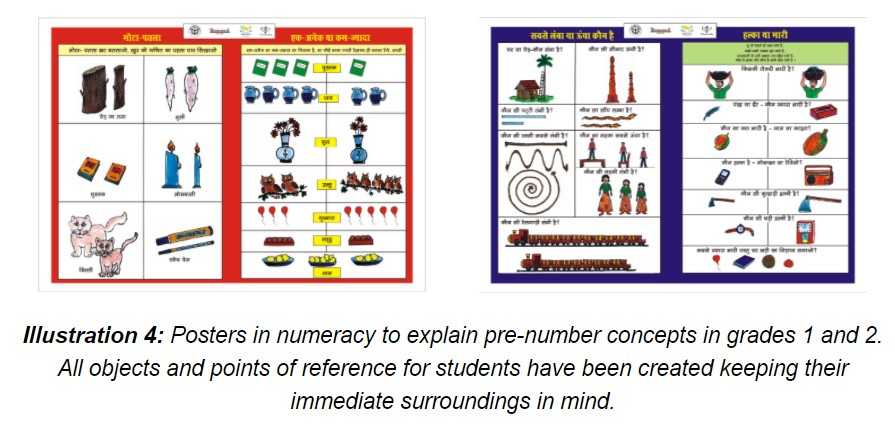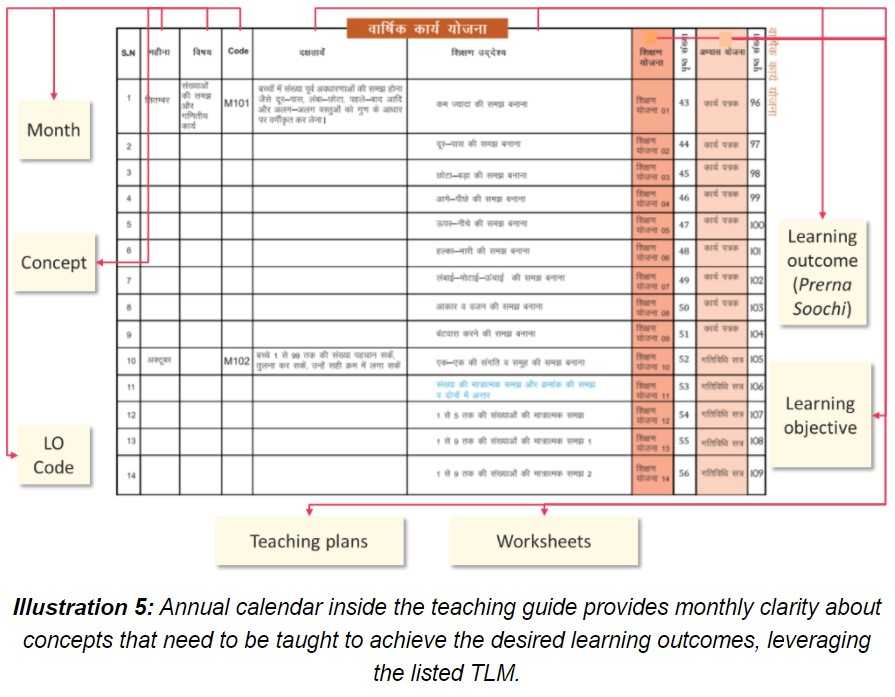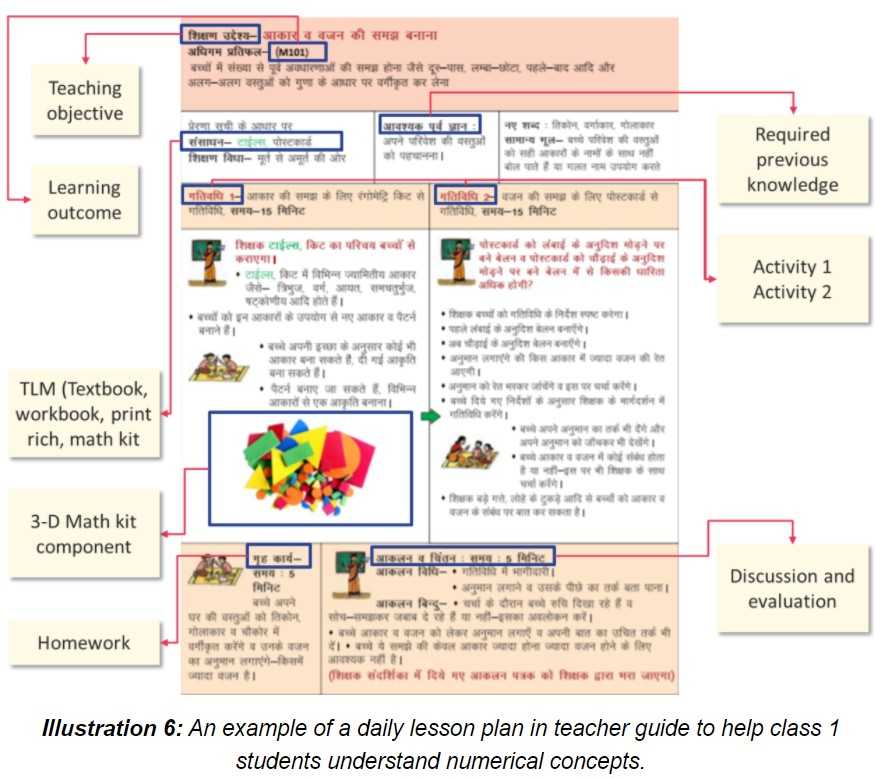Uttar Pradesh, under its Mission Prerna programme is working towards improving the quality of education in its 1.5 lakh primary schools. The state aims to achieve universal Foundational Literacy and Numeracy (FLN) by 2022 for its 1.2 crore students. Quantifiable goals for achievement of foundational literacy across bhasha (language) and ganit (numeracy) have been articulated in the ‘Prerna Lakshya’ (see illustration 1). The state has developed a comprehensive academic strategy to prepare the classrooms for a major transformation to achieve this target. A couple of key elements of this strategy include making classrooms resource rich and empowering the teachers with the right ‘tool kit’ to achieve the targeted learning outcomes for students.
Understanding the problem and developing appropriate Teaching Learning Material (TLM)
Classroom transformation programmes can often take an overly ambitious route and introduce materials that in theory fulfil the learning needs of children, but in practice don’t deliver on the promise. A diagnostic study was conducted in Uttar Pradesh to understand why this happens. The study analysed student learning levels and teaching-learning materials being used in classrooms.
The diagnostic study revealed a few important patterns that informed the development of appropriate classroom material. Some of the gaps it highlighted included: little to no relation of the content with the child’s environment; standardised level of difficulty which does not account for the children's varied learning levels; and no relation with pre-existing material inside the classroom, etc.
To ensure that children learn more meaningfully in classrooms, Mission Prerna ensured a holistic academic design strategy. New interventions were designed and materials developed post this diagnostic study to overcome specific challenges identified in the study:
1. Creating Print-rich Classrooms
One of the most crucial components for developing literacy skills among children is enhancing their ability to read with comprehension. And a print-rich environment helps with improving that ability among children. Charts, posters, banners, and painted walls in classrooms provide children with the opportunity to actively engage with their immediate environment thereby helping them learn. Children could also be surrounded by such material at home. However, given the socio-economic background of the majority of the students that form the classroom in a government primary school in UP, that was not the case.
Under Mission Prerna, the Government of Uttar Pradesh, will be providing each school with the following to create print-rich classrooms:
1.1 10 conversation charts (see illustration 2)
Conversation charts are essentially visuals of everyday, routine things which children can interpret and hold conversations or discussions about. They are developed keeping in mind the socio-cultural surroundings and economic backgrounds of the children.
These are being designed as A2 size handouts so that teachers can also hold them conveniently to perform activities with. An example of an interactive activity could be students sitting in a circle around the teacher with the chart and then describing to the teacher what they see.
1.2 10 posters (see illustration 3)
Posters include a brief story or poem accompanied by related visuals. Stuck to classroom walls, they encourage reading among children.
1.3 Numerical charts and posters (see illustration 4)
20 charts and posters will be provided to increase children’s engagement with mathematical concepts. These charts explain simple concepts such as pre-numbers and mathematical operations (+, -, *, /) using engaging illustrations and text.
In addition to providing these resources, efforts under the programme will continue to motivate teachers to create more such resources. These will act as a starting point for classrooms otherwise devoid of a print rich environment.
2. ‘Manipulatives’ for Mathematical Concepts
Manipulatives are physical teaching tools like coins or blocks that help children understand and make sense of abstract mathematical concepts. These are essential to build foundational numeracy skills among children.
It was observed that teachers created their own manipulatives using rocks, twigs, matchsticks, straws and other easily available material succeeded in making their classes more interactive and engaging. However, these teachers were exceptions.
To ensure that the use of manipulatives became standard practice in every classroom, the state government provided each school with an 11-item math kit which includes 3D shapes, currencies, clocks, beads, etc. This enabled children to learn abstract concepts with more hands-on experience rather than from textbooks.
3. Enabling Reading to Hone Literacy Skills
From the diagnosis, it was found that the state textbooks were not graded for difficulty. Consequently, children whose reading skills were not at par with grade-level textbooks fell behind. The gap between the difficulty level and children’s reading skills kept widening with each passing day. This became a particularly important challenge to solve for.
In addition to providing resources for print-rich classrooms, the state is also providing graded reading books called ‘Sehej’ for Classes 1-3. Designed for each of the three grades, ‘Sehej’ has poems, stories, illustrations, and on occasion, simple exercises to engage the early reader in learning and comprehension.
4. Empowering Teachers With Tools and Skills
4.1 Teacher’s Guide
Given the new material introduced in the state with a guided focus on Foundational Literacy and Numeracy, it became important to tie it all together in a guiding document for teachers to ensure they help children learn more effectively.
Designed mainly for teachers of Classes 1-3, the key features of the Teacher’s Guide includes an annual calendar which indicates what concepts should be taught at what stage, for how long, and the anticipated learning outcomes (see illustration 5). It also includes weekly planning templates and daily lesson plans (see illustration 6).
This guide has been developed to empower teachers to maximise learning outcomes. It will help teachers with clarity on how to teach children at their levels and help them catch up. It will guide them on what materials can be used to explain which concepts, the approximate duration children might need to grasp a particular skill or concept among other things. The TLM currently in production has been referenced extensively in the guides to ensure ease of use and compliance.
4.2 Teacher Training
For the seamless introduction and adoption of TLM in classrooms, and to ensure clarity on the part of teachers, a 4-part video training series is currently underway. These videos demonstrate how each element of the academic strategy can be leveraged with the teacher’s support inside the classroom to achieve learning objectives. In addition to this, the state has started organising direct sessions with teachers through YouTube to motivate them and gear them up for using the new materials.
In conclusion, TLM is an integral to improved FLN skills among children. Creating print-rich classrooms and empowering teachers with tools that help children learn in engaging and interactive ways will help maximise learning outcomes. This is a huge step towards achieving Mission Prerna’s goal of acquiring universal FLN by 2022.
(This blog was previously published on the Central Square Foundation's website.)
__

